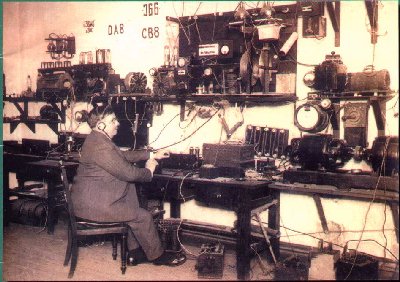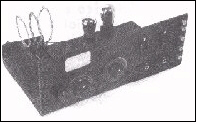|
A Trascendental Comunication
|
The History Radiophonic communiqué of Carlos Braggio.
Record of distance (21st May, 1924)

The velocity with which the event actually develop, may take us to lose sight of some past's knowledge that deserve to be emphasize. That's what happen with the history communiqué Carlos Braggio, r-CB8, from Bernal, Buenos Aires, Argentine, and Ivan O'Meara, r-2AC, from Gisborne, New Zealand, that established the record of distance in 11.000 km.
This event produced a real shock, not only between the radiophonic enthusiasts of all the world, but between the scientists and technicians too, because its concretion meant the collapse of the theories about the electromagnetic waves propagation that were in vogue, since the band used (2,5 Mc/s) was pracrtically unexplored.
In Argentine, a little group of enthusiast was dedicated to experiment on the new invention of the radio, managing to get in contact among themselves and broadcasting recorded music and news in an amateur form. The great jump took place in the 1920 decade, when the military secret jealously kept since the First World War was raised, and the first thermionic tubes arrived at our country. This even made the radio popular; several magazines of that time published thecnical articles with the instructions for making equipments, for examples Telegraphical Magazine and Radio Magazine. Meanwhile, Carlos Braggio and his son Juan Carlos strove to perfect the receivers, making them more selective, managing receive stations of EE.UU., as the famous KD-KA from Pittsburg, and hoping for establish a bilateral communication. The head of traffic of the A.R.R.L., Fred Schenell, proposed the argentinians to use the band of 100 to 200 meters of wavelength (3 a 1,5 Mc/s), since the wavelength used up to then (500 Kc/s) because impossibile the receipt in EE.UU., because of the broadcastings interferences.

The date for the experience performing was set on 19th to 31th may, 1924, and the local transmission time was from 0200 to 0430, and from 0500 to 0730 for EE.UU., Greenwich's time for both of the cases (today UTC). It was established a wavelength between 105 to 125 meters, and between 150 to 200 meters (2,4 to 2,8 Mc/s, and 1,5 to 2 Mc/s), and it was agreed to use telegraphy as the transmission mode, in order to its great efficiency.
Carlos Braggio and his son quickly improvised a transmittier, Hartley system auto-excited with 4 tubes Radiotron 203A of 50 Watts of dispelling each one, with 1000 volts in plate, all that provided around 300 Watts of power. The receiver was a direct regenerative with 2 tubes. The antenna was aperiodic (non resonant), cape-type and vertically supported by a mast 33 meters high, with counter-antenna of 8 horizontal wires 12 meters long, tuned in by variometers.
The nigth of May 20th to 21th, as on the proceding, Braggio and his son, were realizing trials without positive results, since they heard american stations, but they couldn't establish a contact. on 0355 of 21st, before taking a rest, they decided to do a last call. After passing the change, they received a reply of an unknown station, which invited then to talk. Braggio asked it QRA and QTH, and was in that case when the surprise took place: "2AC, Gisborne, New Zealand answers you". The emotion had to be indescribable for this enthusiasts, who communicated to such a distance with that modest equipment. According to Carlos Braggio, the communicated developed as follows:

"After a CQ calling to North America, I syntonize the 2AC station that call to CB8.
I it asking QRA. It answer me:
2AC:-2AC, New Zealand, your signals QSA.
CB8:-Very happy of receiving your answer, that is a good record. Congratulations, QRA.
2AC:-Thanks, I reward congratulations, QRA.
CB8:-My name is Carlos Braggio, Alsina St. 412th, Buenos Aires, I beg you to give me your address, I want to interchange a cable -...(The answer of 2AC was interrupted by statics).
2AC:-Please repeat name and address. - Your signals are better now.
CB8:-Perfecthy received. Your signals change a lot. Now you have a new friend here. Tomorrow I'll call you at 0700 GMT; here it's foul weather, there are discharges and it's raining. New congratulations. Here it's 0540 a.m. Good morning and till tomorrow.

2AC:-Here it's 0950 p.m. Very good, at 0700 the morning. ¿Is it day there;?
CB8:-No, but it's dawning. There are many discharges. Good morning, till tomorrow.
Hours later, Braggio sent a cable to O'Meara, which was answered and appears in the photography as a conclusive evidence of the history communiqué.
These modest and meritorious enthusiasts clear the way for the subsequent development of the international communications; that's the reason by which this event deserves the admiration and the affectionate memory of all us.
|